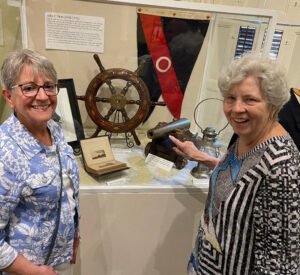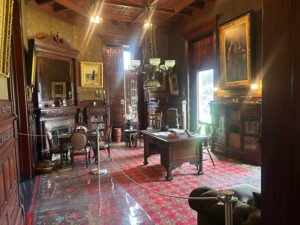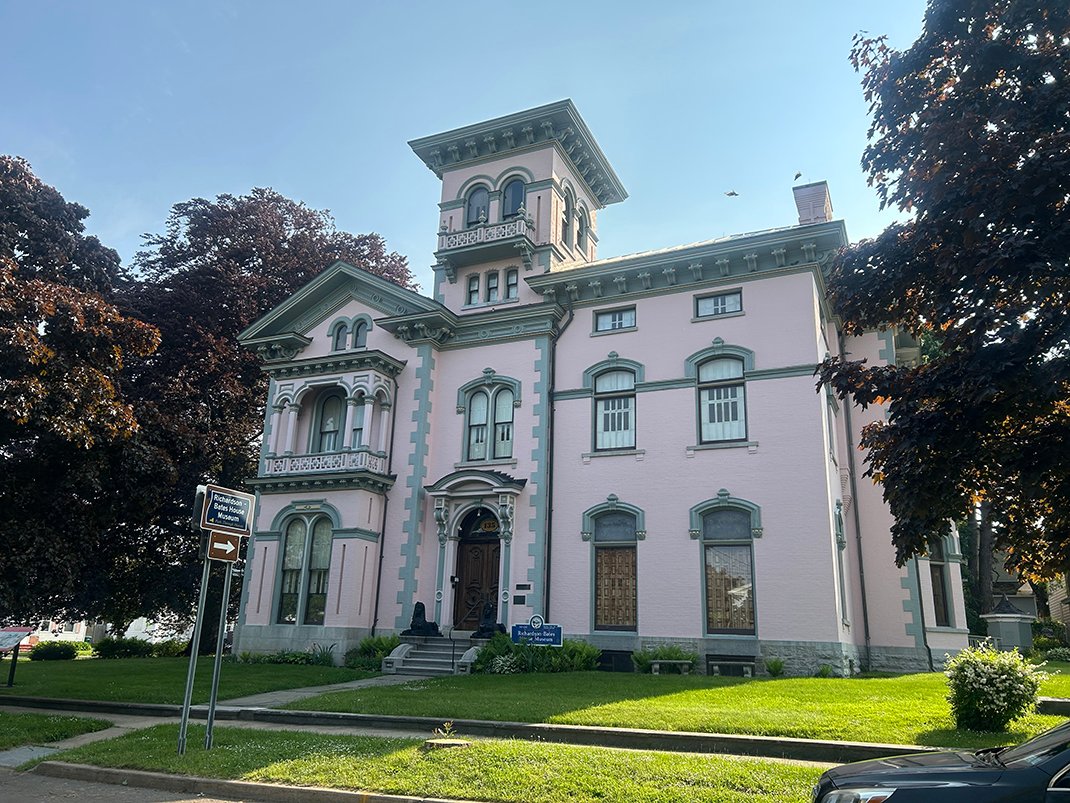By Stefan Yablonski

The first floor of the Richardson-Bates House (Museum) reflects the art and culture of the 19th century Victorian elite. Meanwhile, the upper floors ooze history from nearly every nook and cranny.
The house was built for Maxwell Richardson — a real estate attorney, insurance broker and two-term mayor of Oswego. The house still has about 95% of the original first floor furnishings.
A lifelong bachelor, he lived in the house with his widowed mother, Naomi Richardson; his divorced sister, Harriet Richardson Bates, and her son.
Harriet’s son, Norman Bates, was the sole heir to the Richardson family and inherited the house in 1910. He lived in the house with his wife, Florence and their four children: Betty, Norman Jr., Sally and Maxwell, along with at least two live-in servants.
In late 1946, the house and its contents were donated to the Oswego Historical Society.
Now, the historic 19th century Italian villa serves as the society’s permanent headquarters and a public museum.
It was listed on the National Register of Historic Places in 1975.
The Dr. Mary Walker collection — including her Congressional Medal of Honor for Meritorious Service — is housed at the site.
“Only one person knew where [the medal] was kept and then two … because there was such a fear of it being stolen,” said Eva Corradino, society president. “It got to a point where one of our board members — we were talking about having a way to display it — he said if we are not going to do it we need to give it to someone who will display it.”
The society embarked on a campaign to be able to securely display the artifact.
“We saw the fruition of the campaign to make Dr. Mary Walker’s Congressional Medal of Honor available for public viewing,” she said.
They had been asked to share the medal with the Congressional Medal of Honor Museum.
“We loaned a few things to one museum,” said Mary Kay Stone, past president.
“Certainly not the medal,” Corradino added.
“There was a second medal that she was issued when they redesigned it. We had both of them and that medal was stolen when we loaned it for an exhibit. It was never recovered. Luckily it was the secondary medal,” she continued. “But there was this terror on the board [about the medal’s security]. So that was a big job to raise enough money [for security] and to get cameras. We had no cameras in the house at all. Now we have a much stronger security system. It came to just over $30,000.”
“Now we have a humidity-controlled case, it has a shake alarm. It’s a real museum case,” Stone said.
“That [campaign] was a really big deal. There was tremendous response to it all over the county and especially town of Oswego people. There were organizations that would give us hundreds of dollars at a time and then there were local people who would give us $25, $50, $100 whatever,” Corradino said. “This campaign went on and by spring, we had enough money raised already. By spring we could go ahead and order the case and start putting in the security system. We raised the money so quickly compared to what we thought it would take.”
What are the plans now?

“Besides everything?” Stone asked rhetorically.
“Last year we had to do the gutters because they were so clogged and damaged; the downspouts and all of that,” Corradino said. “Some could be repaired, some had to be replaced. That was a big project.”
One necessary campaign was keeping water out of the basement. Some times it would look like a flood down there in one spot. A dehumidifier is running in the basement constantly.
A drier basement enabled the remodel of the old laundry room, turning it into a useful storage area. They have also made improvements to the storage areas on the second and third floors.
Electrical wiring was upgraded and new outlets were added. An old gas water heater was replaced with a smaller electric model. All unused natural gas lines were either capped or removed.
“We also have a goal to get an elevator back in here,” Stone said.
In the 1930s when Florence, Norman’s wife, was getting older she cut a section out of the bathrooms on the second and third floors and she installed an elevator that went from the basement up to the fourth floor attic.
It has been taken out and now used for storage space.
“But now that we have the Mary Walker exhibit up there, many people can’t climb those stairs,” Stone explained. “We want to be accessible for everybody and the shaft is still there. Now we just have to raise more than $70,000 — it’s a little more than our yearly budget [of $70,000].”
“Maybe an ADA grant or something could help. Having us fully accessible would be a big deal,” Corradino said. “The first floor is accessible, but if you use a walker or wheelchair — you can’t make 20 steep steps.
“Especially in the summer when a lot of people are visiting. There might be a family group, like three generations. You’ll have one or two that sit on a bench at the bottom of the stairs and wait for the rest of the family to see the second floor. Now that we have the Dr. Walker exhibit that has drawn a lot of attention and we would like everyone to be able to see this.”
Donations galore
“There is a lot of stuff around here that was donated — with little or no documentation. But we have resources, people who can help piece together information,” Stone said.
Donations include photographs, artwork, documents, artifacts and more; stored in boxes and on shelves from floor to ceiling. Some have been cataloged, some haven’t.
Do they have room to display all this?
“No,” Corradino chuckled. “We only do a little bit of rotation because the main floor — the whole deal was that the main floor would be a house museum dedicated to the family. So we can’t go taking down their art and putting up new stuff. On the second floor we have two galleries; there is a permanent gallery that right now is a timeline of the county. We are starting to change out and update some things in there. The temporary gallery, which was Max’s master bedroom, is the Dr. Mary Walker exhibit. Some things do come out of the attic and get to be on display.
“Or somebody else in the county, an organization or whatever, that has something that they would like to do … like last year, the Oswego Yacht Club had a beautiful display.”
“They are one of the oldest yacht clubs on this side of the lake,” Stone said.
“We got things from their collection, some things from our collection. John T. Mott was the founder of the Oswego Yacht Club and his great-granddaughter, Nancy Mott Frank, still had some of his stuff — ship’s wheel and other stuff that she loaned to us,” Corradino said.
The opulent interiors of the Richardson-Bates House reflect the art and culture of the 19th century Victorian elite.
Large mirrors and handcrafted furniture are featured in every room.
Several mounted heads of game animals and wild birds are scattered around. There were more [stuffed heads], but Florence didn’t like them so a lot were taken down, Corradino said.
Oswego Historical Society
The Oswego Historical Society, founded in 1896.
The Richardson and Bates families were active members of the Oswego County Historical Society.
Maxwell joined the society in its first year; Norman was secretary of the society until his death in 1923; and Florence, shortly after her husband’s death, was one of the first women allowed into the society.
Florence was a significant benefactor to the city’s charities and in 1944 helped Ruth Gruber organize an open house at the newly created Emergency Refugee Shelter at Fort Ontario where 982 European refugees of the Holocaust had arrived in August to take up temporary residency for the duration of the war. The open house was instrumental in dispelling rumors that the refugees lived in luxury while Oswego suffered with wartime rationing and scarcities.
Following Florence’s death in 1945, the three surviving children donated the house, along with much of its remaining furnishings and most of Norman and Max’s military and ethnographic collections, to the historical society, intending it to serve as a public museum in memory of their family and to be the society’s headquarters.
Richardson-Bates House Museum:
135 E. Third St., Oswego
Hours: Thursday – Saturday: 1 – 5 p.m.
April through December



